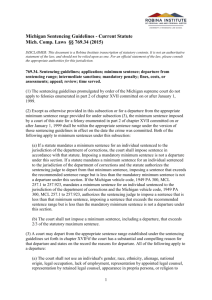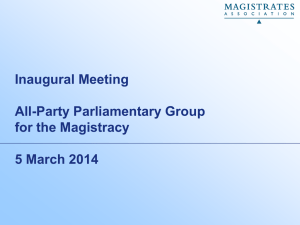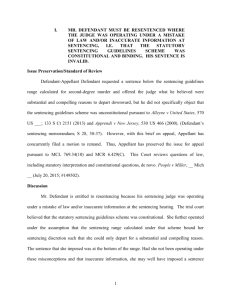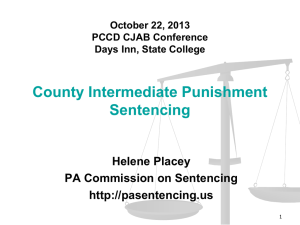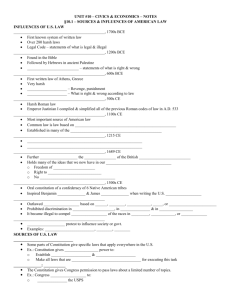IN THE UNITED STATES DISTRICT COURT FOR THE NORTHERN
advertisement
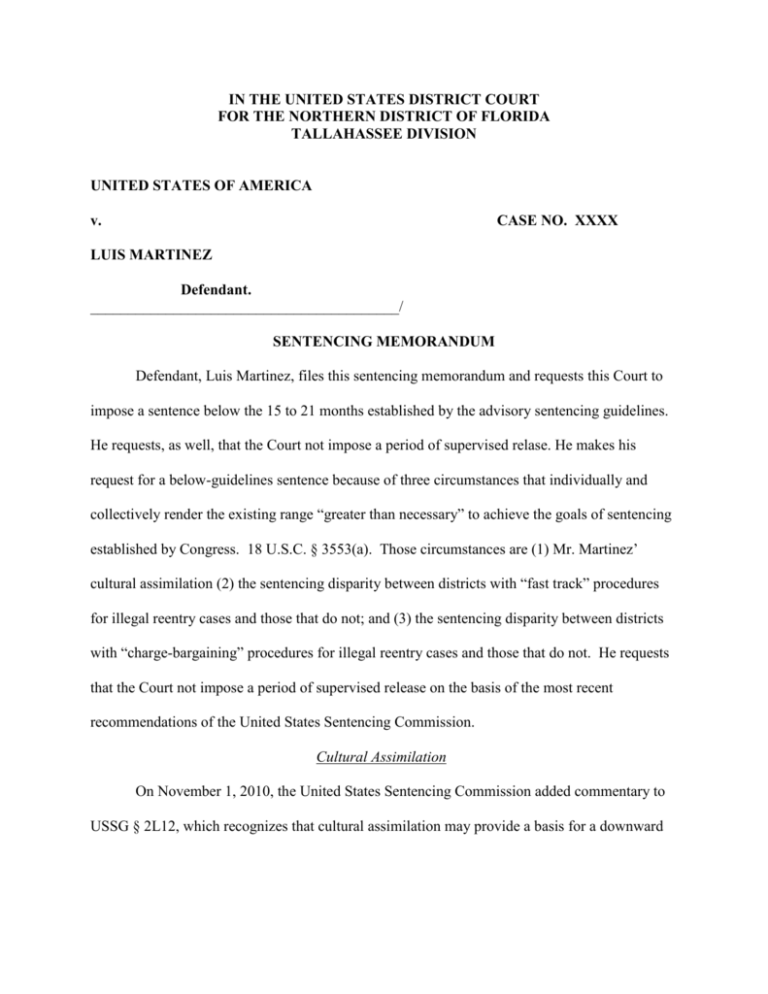
IN THE UNITED STATES DISTRICT COURT FOR THE NORTHERN DISTRICT OF FLORIDA TALLAHASSEE DIVISION UNITED STATES OF AMERICA v. CASE NO. XXXX LUIS MARTINEZ Defendant. _________________________________________/ SENTENCING MEMORANDUM Defendant, Luis Martinez, files this sentencing memorandum and requests this Court to impose a sentence below the 15 to 21 months established by the advisory sentencing guidelines. He requests, as well, that the Court not impose a period of supervised relase. He makes his request for a below-guidelines sentence because of three circumstances that individually and collectively render the existing range “greater than necessary” to achieve the goals of sentencing established by Congress. 18 U.S.C. § 3553(a). Those circumstances are (1) Mr. Martinez’ cultural assimilation (2) the sentencing disparity between districts with “fast track” procedures for illegal reentry cases and those that do not; and (3) the sentencing disparity between districts with “charge-bargaining” procedures for illegal reentry cases and those that do not. He requests that the Court not impose a period of supervised release on the basis of the most recent recommendations of the United States Sentencing Commission. Cultural Assimilation On November 1, 2010, the United States Sentencing Commission added commentary to USSG § 2L12, which recognizes that cultural assimilation may provide a basis for a downward departure from the guideline range. USSG App. C, Amend. 740.1 The new language reads as follows: There may be cases in which a downward departure may be appropriate on the basis of cultural assimilation. Such a departure should be considered only in cases where (A) the defendant formed cultural ties primarily with the United States from having resided continuously in the United States from childhood, (B) those cultural ties provided the primary motivation for the defendant’s illegal reentry or continued presence in the United States, and (C) such a departure is not likely to increase the risk to the public from further crimes of the defendant. In determining whether such a departure is appropriate, the court should consider, among other things, (1) the age in childhood at which the defendant began residing continuously in the United States, (2) whether and for how long the defendant attended school in the United States, (3) the duration of the defendant’s continued residence in the United States, (4) the duration of the defendant’s presence outside the United States, (5) the nature and extent of the defendant’s familial and cultural ties inside the United States, and the nature and extent of such ties outside the United States, and (6) the seriousness of the defendant’s criminal history, and (7) whether the defendant engaged in additional criminal activity after illegally reentering the United States. USSG § 2L1.1, comment. (n. 8). There are several reasons why consideration is due an individual who has become assimilated into the culture of the United States. In United States v. Reyes-Campos, 293 F. Supp. 2d 1252, 1258 - 1259 (M.D. Ala. 2004), citing United States v. Lipman, 133 F.3d 726 (9th Cir. 1998), the court recognized “two ways in which a defendant’s cultural assimilation to the United States could ‘speak to his offense and to his character’” : The court wrote that “cultural assimilation may be relevant. . . if a district court finds that a defendant’s unusual cultural ties to the United States - - rather than ordinary economic incentives - - provided the motivation for the defendant’s 1 In Paragraph 75 of the Presentence Report, the Probation Officer has stated that the defense objects to the absence of any mention of a departure on the basis of cultural assimilation, and mentions that three circuits have held that cultural assimilation may support a departure. There was at one point some question about whether cultural assimilation would support a departure, but the commentary added as a result of Amendment 740 has conclusively resolved the issue. illegal reentry.” Id. Cultural assimilation may also be relevant to the character of a defendant. . . in so far as his culpability might be lessened if his motives were familial or cultural rather than economic.” Id. United States v. Reyes-Campos, 293 F. Supp. 2d at 1256. Then, too, in weighing the extent of the punishment to be imposed, courts have recognized that deportation is an especially harsh penalty. See Padilla v. Kentucky, 130 S.Ct. 1473, 1481 (2010) (“We have long recognized that deportation is a particularly severe ‘penalty’ . . .”). That is even more true when the individual being deported has been assimilated into the culture of the United States and has no connection with the country to which he or she is being deported. All three considerations - motivation for committing the offense, character, and what amounts to an especially harsh collateral penalty - apply in this case. Mr. Martinez came to the United States when he was eight years old. PSR ¶ 45. He grew up and was educated in the United States. PSR ¶ 51. Nearly all of his family, including his three young children, live in the United States. PSR ¶¶ 46-47. The commentary lists seven circumstances that the Court should consider, and all of them apply to Mr. Martinez. As stated, he was eight years old when he came to the United States. As he is now 25 years old, he has been in the United States for the last seventeen years. During that time he attended school within the United States and has been outside the United States only briefly when he was deported. With children in the United States, with his mother present, and all but one of his siblings, he has extensive familial ties. Given the length of time he has been in the United States, his cultural ties are strong, as well. Other than his brother who was deported a year ago, Mr. Martinez does not have any relatives with whom he is familiar outside the United States. While Mr. Martinez is not without a prior criminal history, other than his efforts to avoid detection and his illegal entry offense, his last offense was a 2004 DUI conviction when he was eighteen years of age. Furthermore, he has not, since his most recent return to the United States, “engaged in additional criminal activity after illegally reentering the United States.” USSG § 2L1.2, comment. (n. 1(7)). Disparity Due to Fast-Track Programs In 2003, Congress directed the United States Sentencing Commission to issue “a policy statement authorizing a downward departure of not more than four levels if the government files a motion for such departure based on the early disposition program authorized by the Attorney General and the United States Attorney.” Prosecutorial Remedies and Other Tools to end the Exploitation of Children Today Act (PROTECT Act), Pub. L. No. 108-21, §401(mc0(2)(B), 117 Stat. 675. In accord with that directive, the Sentencing Commission promulgated USSG § 5K3.1, which authorizes a downward departure of “not more than 4 levels.” Had Mr. Martinez been arrested in one of the fast-track districts, it seems likely he would have received somewhere between a 2 to 4 level reduction in the offense level or as little as a 6 month sentence. See generally Exhibits 1 and 2.2 It is a disparity that the Sentencing Commission has recognized to be inconsistent with Congress’s goal of sentencing uniformity. See United States Sentencing Commission, Report to Congress: Downward Departures from the Federal Sentencing Guidelines 66-67 (2003) (“Defendants sentenced in districts without authorized early disposition programs, however, can be expected to receive longer sentences than similarly-situated defendants in districts with such programs. This type of geographical disparity “Exhibit 1” is a District by District Count of Fast Track Policy and Procedures, reprinted in 21 Fed. Sent. Rptr. 229, 339-348 (June 2009). “Exhibit 2" is a Memoranda Reporting Revisions to the Illegal Reentry Fast Track program in the Central District of California, reprinted in 21 Fed. Sent Rep. 349 (June 2009). 2 appears to be at odds with the overall Sentencing Reform Act goal of reducing unwarranted disparity among similarly-situated offenders.”)3 Mr. Martinez recognizes that this Court is bound by existing Eleventh Circuit Court of Appeals precedent and that the Eleventh Circuit has held that trial courts lack the authority to impose a below-guidelines sentence on the basis of fast-track disparity. See United States v. Castro, 455 F.3d 1249 (11th Cir. 2006); United States v. Arevalo-Juarez, 464 F.3d 1246 (11th Cir. 2006); and United States v. Vega-Castillo, 540 F.3d 1235 (11th Cir. 2007). There has, though, been debate within the Court. See Vega-Castillo. 540 F.3d at 1239 (Barkett, J. dissenting). Then, too, Judge Carnes, in the opinion denying the motion for rehearing en banc in Vega-Castillo , seemed to acknowledge that closer review of the issue might be warranted in a more appropriate case. United States v. Vega-Castillo, 548 F.3d 980, 981 (11th Cir. 2008).4 Notably, other district have concluded that trial courts do have the authority to impose a below-guideline sentence on the basis of fast-track disparity. See, e.g., United States v. Rodriguez, 527 F.3d 221, 229 (1st Cir. 2008); United States v. Arrelucea-Zamudio, 581 F.3d 142, 149 (3rd Cir. 2009); and United States v. Camacho-Arellano, 614 F. 3d 244, 250 - 251 (6th Cir. 2010). Disparity Due to Charge-Bargaining Programs 3 The report is available at http://www.ussc.gov/departrpt03/departrpt03.pdf. One of Judge Carnes’s concerns was that Mr. Vega-Castillo had not complied with one of the prerequisites of the fast-track program, that of entering into an agreement waiving certain rights. 548 F.3d at 982. The Government, here, has not offered Mr. Martinez an opportunity to participate in the fast-track program, but he is more than willing to enter into the sort of agreement cited by Judge Carnes in exchange for the benefits of the fast-track procedures. 4 There is, in addition to the fast-track program, a charge-bargaining process that results in reduced sentences for defendants who are prosecuted for the offense of unlawful reentry. These programs operate outside the Guidelines and the benefit to defendants often exceeds what would ordinarily be considered: Based on the parties' submissions, there are a significant number of districts with early disposition programs that operate outside the bounds of the PROTECT Act and § 5K3.1. The government's submission reflects that there are two distinct types of fast track programs: those which, consistent with § 5K3.1 and the Congressional directive, rely on downward departures of up to four levels, and those which rely on charge-bargaining, in other words, where the defendant is permitted to plead guilty to a reduced charge. The fast track districts that rely on charge-bargaining use methodologies that permit far greater sentence reductions that contemplated by Congress' directive in the PROTECT Act and the Sentencing Commission's policy statement in § 5K3.1. In at least five of the fast track districts (the Northern, Central, and Southern Districts of California, the District of Oregon, and the Western District of Washington), persons charged with illegal reentry under 8 U.S.C. § 1326 are permitted to plead guilty to two counts of improper entry under 8 U.S.C. § 1325. The effect is to limit the sentence to thirty months' imprisonment: the first offense under § 1325 carries a six month maximum prison sentence, and the second offense carries a twenty-four month maximum. Charge-bargaining in these districts can, in many cases, result in a sentence reduction that significantly exceeds that which the defendant would receive if he were limited to the four-level maximum departure authorized by Congress in the PROTECT Act and by the Sentencing Commission in § 5K3.1. This can be illustrated by reference to Medrano-Duran's case. Medrano-Duran's criminal history category is IV, and his total offense level is twenty-one, yielding a range under the Guidelines of fifty-seven to seventy-one months. A one-level downward departure as provided in the departure-based early disposition program of some divisions of the Western District of Texas would reduce his range to fifty-one to sixty-three months. A two-level downward departure, as provided in the departure-based fast track programs in the Districts of New Mexico, Nebraska, and Idaho, as well as the Southern District of Texas and some divisions of the District of Arizona, would reduce his range to forty-six to fifty-seven months. A threelevel downward departure, as provided in the program in effect in other divisions of the District of Arizona, would reduce his range to forty-one to fifty-one months. A four-level downward departure, as provided in the departure-based fast track programs in the Eastern District of California and the District of North Dakota, would reduce his range to thirty-seven to forty-six months. Each of these programs falls within the scope of Congress' mandate and the Sentencing Commission's policy statement. But in the charge-bargaining districts referenced earlier, Medrano-Duran's sentence would be thirty months - seven to sixteen months lower than the most lenient of the programs that can be said to carry the Congressional imprimatur. United States v. Medrano-Duran, 386 F.Supp.2d 943, 946-947 (N.D. Ill. 2005). See also Exhibit 1, at pp. 2 - 5. The disparities created by these charge-bargaining programs are not the result of Congressional policy and Mr. Martinez knows of no case that prohibits district courts from considering such a disparity in arriving at a sentence. Thus, while existing Eleventh Circuit precedent may bar this Court from imposing a below-guidelines sentence based upon disparities in sentencing created by the fast-track program, that precedent does not prevent this Court from recognizing the disparity created by charge-bargaining and providing a remedy. Supervised Release On May 1st of this year, the United States Sentencing Commission submitted to Congress a series of amendments to the Sentencing Guidelines that, absent congressional action, will take effect on November 1, 2011. See United States Sentencing Commission, Amendments to the Sentencing Guidelines.5 One of the proposed amendments modifies the existing rule regarding the imposition of supervised release and specifically provides that sentencing courts “ordinarily should not impose a term of supervised release in a case in which supervised release is not required by statute and the defendant is a deportable alien who likely will be deported after imprisonment.” USSG §5D1.1(c) (proposed). See United States Sentencing Commission, supra, at 83. The Commission has made the proposal based on its acknowledgment of what has been obvious for some time - nearly all noncitizen defendants are deported when convicted of a federal offense and that existing law provides for a new prosecution if the individual returns: 5 Available at: Non-citizens now are approximately half of the overall population of federal offenders, see 2010 Sourcebook of Federal Sentencing Statistics, Table 9 (showing that 47.5% of federal offenders in fiscal year 2010 were non-citizens), and supervised release is imposed in more than 91 percent of cases in which the defendant is a non-citizen, see Federal Offenders Sentenced to Supervised Release at 60. The Commission determined that such a high rate of imposition of supervised release for non-citizen offenders is unnecessary because “recent changes in our immigration law have made removal nearly an automatic result for a broad class of noncitizen offenders.” Padilla v. Kentucky, 130 S. Ct. 1473, 1481 (2010); see also id. at 1478 (“[D]eportation or removal . . . is now virtually inevitable for a vast number of noncitizens convicted of crimes.”). Furthermore, such offenders likely would face prosecution for a new offense under the federal immigration laws if they were to return illegally to the United States. United States Sentencing Commission, supra, at 82. While the proposed amendment is not yet in effect, there is no statutory requirement that the Court impose supervised release, and the Court, even if it imposes a sentence of a year or more, has the authority to vary from the existing requirement of USSG §5D1.1. See United States v. Booker, 543 U.S. 220 (2005). Indeed, the logic of the proposal is just as compelling now as it will be in November. In this instance, Mr. Martinez will be deported and, should he return, the Government has he authority to prosecute him. Conclusion Mr. Martinez came to the United States as an eight year old boy and has grown up in this country. His children and the rest of his family live in the United States, and he has few, if any, ties in Mexico. Because his motivation in illegally reentering the United States was based on his cultural and familial ties to the United States and because deportation will, for him, be an especially harsh penalty, he is deserving of consideration for his cultural assimilation. http://www.ussc.gov/Legal/Amendments/ReaderFriendly/20110428_RF_Amendments_Final.pdf Through its explicit approval of lower sentences and fast-track and charge-bargaining districts, the Government acknowledges that reduced sentences for illegal reentry serve all the §3553(2) purposes of punishment. If a sentence of 6 months would serve those purposes in Arizona or Idaho, it would also do so in the Northern District of Florida. Indeed, if fast-track or charge-bargaining sentences sufficiently deter reentry and adequately protect the public in those districts where the offense occurs most frequently, there is little justification for higher sentences in districts where the crime is committed less frequently. Simply put, Mr. Martinez does not deserve to spend additional months in prison because he happened to be arrested in the Northern District of Florida rather than in Nebraska, California, or Oregon. He, therefore, respectfully requests this Court to impose a sentence below the guideline range of 15 to 21 months and to forego the imposition of a period of supervised release. CERTIFICATE OF SERVICE I HEREBY CERTIFY that a copy of the foregoing was delivered by electronic delivery to Ms. Winifred Acosta Nesmith, Assistant United States Attorney, this 10th day of June, 2011. Respectfully submitted, s/Randolph P. Murrell Randolph P. Murrell Federal Public Defender Fla. Bar. No. 220256 227 N. Bronough Street, Suite 4200 Tallahassee, FL 32301 (850) 942-8818 The real name of the defendant has been replaced with a fictional name for purposes of privacy. 13 14

